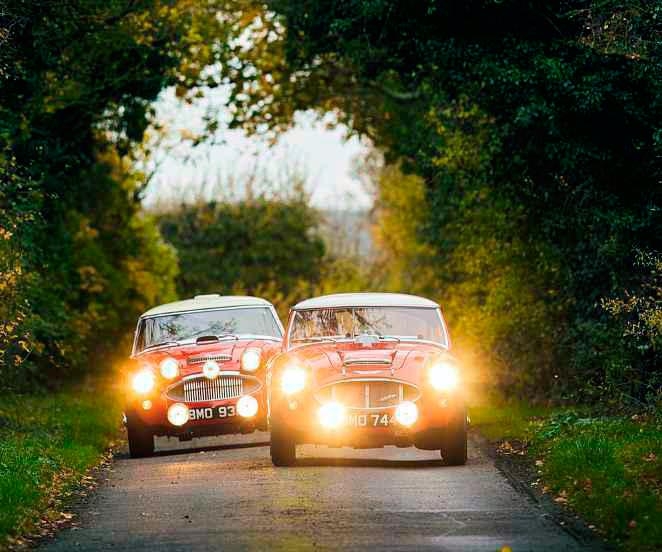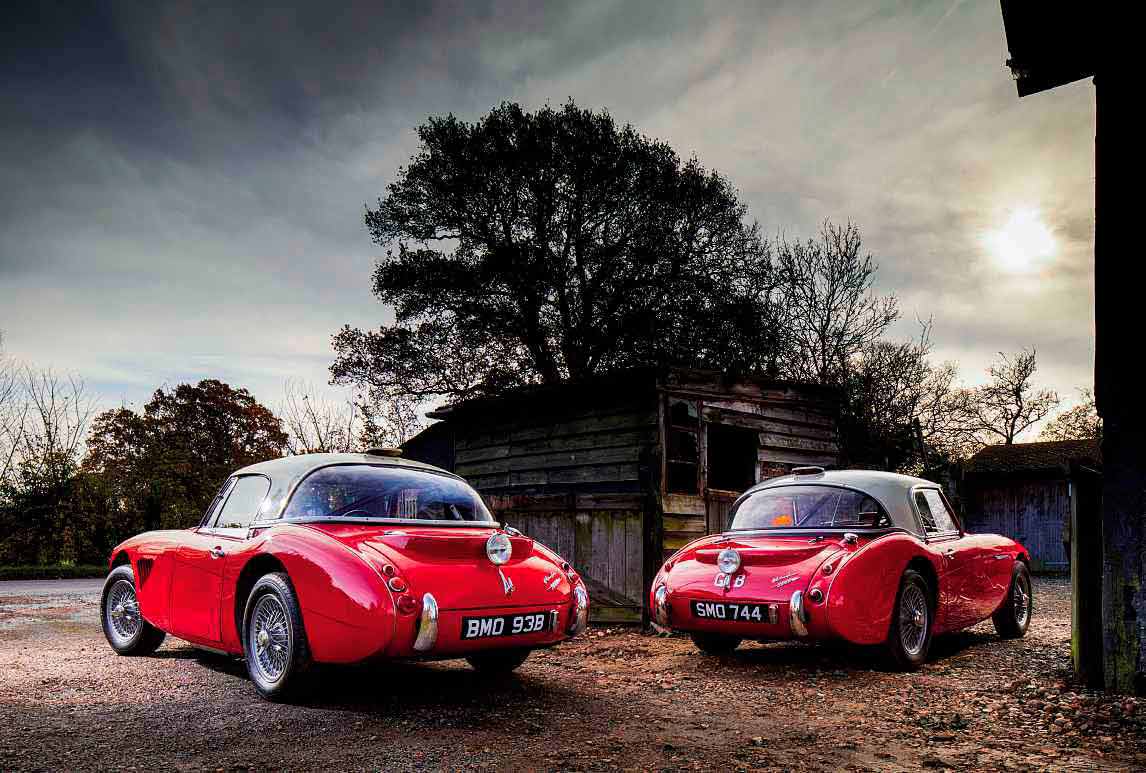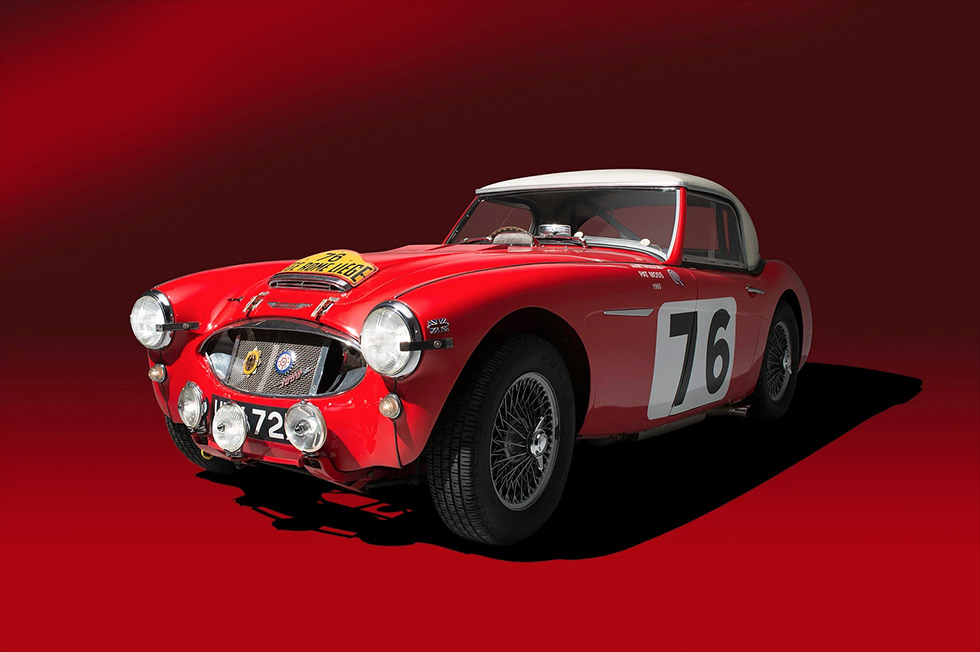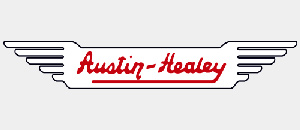
Works Healeys Driving the first and last of the rally 3000s Works Outing. Comparing the first and last of the Austin-Healey 3000 works rally cars reveals strength and character in massive depth. James Page is your guide. Photography Matthew Howel.
Works Austin-Healeys First and last of the epic 3000s
These are perfect roads for a Big Healey – quiet, fast and open, with excellent visibility through the sweeping corners. Our exworks pairing quickly dispatches the occasional hatchback in a flash of spotlights and a six-cylinder bark. Up ahead, Paul Woolmer immediately pulls out a healthy gap despite being at the wheel of SMO 744 – the older and considerably more standard of these two rally icons. Gradually he lets me catch him aboard BMO 39B, a car that is five years younger and which carries within it the lessons learned in the intervening period of intense competition.

After ten exhilarating miles, we switch cars and the differences are readily apparent. As we retrace our route in spirited fashion, it’s clear that the slightly softer SMO is the easier of the two to drive quickly – at least for anyone this side of Rauno Aaltonen. Its triple SU carburettors provide a more user-friendly power delivery than the Webers on the later car, even if it lacks BMO’s sheer punch.
The long side-mounted gearlever can be eased through its considerable travel, in stark contrast to the firm hand that’s required for BMO’s heavy but far more positive centre change. In both cars, the straight-cut ‘Tulip’ (Rally) gear ratios demand the use of overdrive between third and fourth: the sequence goes third, overdrive third, fourth, overdrive fourth. It’s made easier in BMO, with the overdrive switch on the gearknob. In SMO, it’s on the dashboard – there are occasions on which you think that you could really do with three hands.

There are detail differences, too. SMO’s steering wheel is a slender, wood-rimmed item that encourages a lighter touch than BMO’s smaller, chunkier, leather-covered wheel. The later car also has more switches scattered about, which serves a practical purpose. Experience had shown that the more components you could have individually fused and switched, the better. If, for example, you swiped an Alp and damaged a front corner, you’d lose only that light rather than all of them.
Both cars are beautifully sorted, wellbalanced and planted through quick corners. Even SMO feels far-removed from a standard production ’Healey in terms of its handling and manners. Following in Woolmer’s wheeltracks, the squat rear end of his car kicking up autumn leaves, it’s easy to evoke images of the works cars roaring along similar roads in Belgium or France more than 50 years ago.
These two cars – one from 1959, the other from 1964 – neatly book-end the rallying career of the Austin-Healey 3000. They also reflect the way in which the sport was evolving during that period, from a mostly amateur road-based discipline for relatively standard cars, into special stage-based events that featured professional drivers in increasingly specialised machinery.
Although the 3000 is now chiefly remembered for its rallying success, earlier in the model’s life it had been an impressive all-rounder. The Austin-Healey 100 made its competition debut on the 1953 Lyons-Charbonnières Rally in the hands of Gregor Grant and Peter Reece. Later that year, two competed on the Mille Miglia and two were entered for Le Mans. The company even took two cars out to the Bonneville Salt Flats to set new speed and distance records.
The ultimate development of the four-cylinder ’Healey came in 1955 with the 100S, but even by the mid-1950s sports-car racing was becoming the domain of evermore- focused machinery. When the 100/6 was introduced in late 1956 it was a brief step backwards in terms of performance, and competition outings for the new model were sparse in 1957. Tommy Wisdom drove UOC 741 on the Sestrière Rally, though, and by the time of the Mille Miglia it had been fitted with a 12-port head. This hugely improved the breathing of the 2639cc straight-six, boosting both power and torque, and the following season was busier and more successful for the Big Healey.
Final assembly of the road cars had been switched from Longbridge to Abingdon in 1957, and in ’1958 the BMC Competitions Department took over responsibility for the rally ’Healeys – ‘MO’ is an Abingdon registration. Those intended for circuit racing continued to be prepared at Healey’s Warwick base.
Under the watchful eye of the esteemed Marcus Chambers, a five-strong team of 100/6s was entered for the 1958 Alpine Rally, with Pat Moss claiming the Ladies’ Cup and Bill Shepherd finishing seventh overall. Moss and co-driver Ann Wisdom then finished fourth on the Liège-Rome- Liège at the wheel of PMO 201, and in 1959 Jack Sears and Peter Garnier won the GT category on the Tulip Rally.
By then, the 3000 had been introduced. This is the car that finally cemented the ’Healey’s place in rallying history, and it all started with the 1959 works trio of SMO 744 – as seen here – plus 745 and 746. Bill Shepherd retired 744 from the Alpine Rally, but Peter Riley took it to a class win on the Liège-Rome-Liège. In the other two cars, Moss/Wisdom were second overall on the German Rally, and the Morley brothers – Don and Erle – won their class on the RAC Rally. Amateurs in the very finest sense of the word, the Morleys would enjoy considerable success in ’Healeys despite the fact that their schedule had to take account of harvest time on the family farm.
‘The works 100/6s – the PMO cars – were pretty much standard production cars,’ says Austin-Healey guru Paul Woolmer, who looks after these featured 3000s. ‘They weren’t developed much at all. Budgets were tight. By 1959, when the 3000 came out, they wanted to make a big splash publicity-wise, they wanted to promote the new car. But also they had this fabulous car that, by then, was still ahead of its time. That’s why they promoted them so heavily through rallying.’ Whereas the standard 3000s had a pair of 1¾in SU carburettors, the SMO cars had three 2in units. The compression ratio was raised and the camshaft changed, while disc brakes were fitted all round, but fundamentally that was it.
SMO 744 was retained as a works car into 1960. Riley was due to drive it on the Sestrière Rally before the event was cancelled, Moss retired from the Circuit of Ireland, and Riley did likewise on the Acropolis. David Seigle-Morris finished fifth on the Liège, the Morleys were 12th in Germany, and Ronnie Adams closed 744’s career with 39th overall on the RAC Rally.
Throughout the latter part of the 1950s, BMC had often entered multiple models on rallies in the hope of getting a class victory. Even as late as ’1959, in addition to the Austin- Healey 100/6 and 3000, it was represented by the Austin A40 Farina, A35 and A105, Sprite, Riley One-Point-Five, MGA Twin- Cam, Wolseley 1500 and Morris Minor. As the 1960s dawned, however, outright victories were deemed to be more important, and the Competitions Department began to focus its resources upon the Mini and the Big Healey.
‘Rallying was getting more competitive and, to some extent, the cars were perhaps becoming more modified,’ recalls Stuart Turner, who took over from Marcus Chambers as head of ‘Comps’ in 1961. ‘I was lucky enough to sit alongside the man who won the first British Rally Championship in 1958. A couple of days before one round, his car gave trouble. He borrowed a TR3 from his local Triumph dealer and we won the rally. I took the car back to the dealers on the Monday and watched as it went back into the sales demonstrator fleet. You can’t get much more “standard” than that!’
And the Austin-Healey was perfectly suited. ‘The 3000 was strong and simple. It was ideal for events like the Alpine and Liège. I’ll always have a soft spot for it because I did my last event in one before switching to management. It was the Polish with Derek Astle. He was a great character and, seeing a frontier guard in the distance as we came back from the rally, he hurtled along the motorway towards him and stopped the quivering 3000 just a few feet from him. The guard had the perfect response – he knocked the safety catch off on his gun…’
The parent company – BMC – was very supportive. ‘We had a yearly Competitions Committee attended by the chairman and Alec Issigonis. John Thornley – my boss at MG – and I prepared the agenda and I wrote the minutes and was then left to get on with it. Those were the days before Lord Stokes, by the way – for which much thanks.
‘I discussed events a lot with my (mainly UK) co-drivers as well as Doug Watts and the mechanics. I was never under pressure to go here or there to help chase sales – I just went where I thought we could fare best.’
Turner has always maintained that, if you’re going to take over a competitions department, do it just after the Mini-Cooper has been introduced. Issigonis’s revolutionary little design came to the fore as the decade progressed but, as Turner pointed out, there were still events to which the rugged ’Healey was better suited. In 1961, for example, the Morley brothers took overall victory on the Alpine – a result that they repeated in ’1962.
‘The ’Healeys have got a huge chassis on them,’ explains Paul Woolmer; ‘great big chassis rails – and the works also used to strengthen those along the bottom edge. They’d put an extra thickness of steel along them to resist the knocks. And they’d run sump guards as well, of course.’
Even so, there’d still be plenty of damage. ‘The cars used to come back in a hell of a state. I’ve got photos of BMO on the Liège, where it’s suffered so many punctures – the tyres weren’t really keeping up with development. They carried two spares but once they’re gone what do you do? You keep going on the rim, and there are pictures of the rear wheelarches completely destroyed.
‘When the cars came back they’d be stripped and anything that needed replacing would be replaced. The only thing that stayed with the car was the hardtop, because it had the rally stickers in. That was the car’s identity. They’d replace wings and doors and not worry too much about that sort of thing, but the hardtop stayed with the car.’
Before 1962, all the works rally ’Healeys had been built using the two-seater bodyshell rather than the 2+2 variant. Not only was it lighter and stronger, but the rear bulkhead better supported the suspension. In ’1961, BMC had updated the production car: the MkII brought little more than a revised grille and standard triple carburettors. The following year, however, brought further changes, included a more curved windscreen, plus quarterlights and wind-up windows, making the ’Healey increasingly civilised.
The central gearchange was standardised and the two-seater body style discontinued, which meant that later rally cars such as BMO had to use the 2+2 shell – the upside being that there’s more space inside.
There would be one more major production change that was carried over to the works cars. The MkIII Phase 2, introduced in May 1964, used a revised chassis that ‘dipped’ where it passed beneath the rear axle. This meant that the ride height – which had put ’Healeys at a disadvantage on rough roads – could be increased.
That year was the last in which the Austin- Healey formed a major part of the works’ rallying programme, and it went out with a bang. BMO 93B was used twice: the Morley brothers took it to 21st overall on the RAC Rally, but before that Aaltonen and Ambrose had claimed a famous victory on the Spa- Sofia-Liège. Fittingly, it was to be the last traditional running of the Marathon de la Route, which for 1965 would switch to being an 84-hour grind around the Nürburgring.
The endurance nature of the event meant that although BMO and the other works ’Healeys were by then boasting an alloy cylinder head, increased compression ratio, hotter cam and aluminium panels, reliability remained more important than outright performance. It says something for the differing nature of BMC’s two stars that Turner was almost as happy to get a Mini to the finish as he was with the ’Healey’s win.
‘Rauno’s intelligence and his meticulous approach to rallying made him so successful,’ says Turner. ‘He was a great driver.’ Alongside him, Ambrose was equally well-prepared and the pair worked perfectly together. Ambrose drove whenever Aaltonen needed to sleep, one night completing a 77-mile section in only 52 minutes.
In ’1963, they’d been leading until a crash in Italy forced them to retire, but there would be no such heartbreak this time around. As they left the Dolomite mountains, they enjoyed a 28-minute lead over Eric Carlsson. All they had to do was to get safely up to Spa, but to stay awake they changed drivers every half-hour – without stopping. Even allowing for the extra space afforded by BMO’s 2+2 bodyshell, that must have taken some doing. Clearly a master of understatement, Ambrose later admitted that it ‘was not easy’. His final memory from the gruelling event was of falling asleep in a restaurant during the celebrations and embedding his face in a steak tartare.
The following year, Timo Makinen and Paul Easter finished second overall in the RAC Rally – the ’Healey never did win its home event – but the 3000’s time had passed and the Mini had the likes of the Lotus Cortina snapping at its heels. The car that Don Morley once described as a ‘big red hairy monster’ was the last of a dying breed, built to withstand the most gruelling of roadrallies rather than to blitz short stages.
‘I think every driver who drove it was frightened of it,’ said the late, great Pat Moss in a BBC interview. ‘They held the road very well on dry tarmac, but if you hit gravel or sand, let alone ice or snow, it wasn’t very funny. They had 200hp, approximately, at the end, and they were very difficult, but we thought they were great because they were fast.’
Thanks To Paul and Richard Woolmer at Woolmer Classic Engineering, www.woolmerclassic.co.uk.
Toughest rally of all
Even Stirling Moss accedes to his sister on this one…
‘The mark of a great driver is whether his or her eyes moisten at the word “Liège”,’ says Stuart Turner. ‘Over 90 hours – nearly four days and four nights – with a one-hour break. Not per day, just one hour over the four days. Utterly crazy. Utterly magical.’
Four years before Aaltonen and Ambrose took BMO to victory on the same event, Pat Moss and Ann Wisdom had scored one of the ’Healey’s most famous victories aboard URX 727. That year, only 13 of the 83 starters reached the finish of the 3100-mile Liège-Rome-Liège.
Moss and Wisdom safely negotiated the run through Italy and then east into Yugoslavia, assuming the lead as the rally swung back into Italy. It was an advantage that they never surrendered, despite the ’Healey needing a gearbox change and organisers opening the Col d’Allos test to normal traffic while they were still on it. It was the first outright International win by an all-female crew.

‘Their Liège win was just one of The Great Drives,’ concludes Turner. ‘I believe someone suggested to Stirling that his Mille Miglia victory with Jenks was the greatest ever sports-car drive. He said “No – my sister Pat’s win on the Liège was.” Hear, hear!’
Tech and photos
Right and top right Triple Webers help the MkIII push out a fully fledged 210bhp; interior is more modern, though inevitably less luxurious in rally trim.
Left and below Mk1’s delightfully vivid interior is gloriously undisrupted by rally additions, bar harnesses and tripmeter; bigger SUs for rally 3000s.
Above and right Five years, 60bhp and a whole lot of rallying experience separate SMO 744 and BMO 39B; the former punches its way along a twisting lane.
‘OUR EX-WORKS PAIRING QUICKLY DISPATCHES THE OCCASIONAL HATCHBACK IN A FLASH OF SPOTLIGHTS AND A SIX-CYLINDER BARK’
‘THE 3000 IS THE CAR THAT FINALLY CEMENTED THE ’HEALEY’S PLACE IN RALLYING HISTORY’
‘THE CAR THAT DON MORLEY ONCE DESCRIBED AS A “BIG RED HAIRY MONSTER” WAS THE LAST OF A DYING BREED’
TECHNICAL SPECIFICATIONS 1959 Austin-Healey 3000 ‘SMO 744’
Engine 2912cc straight-six, OHV, triple 2in SU carburettors
Max Power c150bhp at 5100rpm / DIN
Max Torque c185ft lb at 3400rpm / DIN
Transmission Four-speed manual with overdrive on third and fourth, rear-wheel drive
Steering Cam and peg
Suspension
Front: lower wishbones, coil springs, lever-arm dampers.
Rear: live axle, semi-elliptic leaf springs, adjustable lever-arm dampers, Panhard rod
Brakes Discs
Weight 1090kg
Top speed 120mph (typically)
0-60mph c12sec (depending on gearing)
TECHNICAL SPECIFICATIONS 1964 Austin-Healey 3000 ‘BMO 93B’
Engine 2912cc straight-six, OHV, triple 45 DCOE Weber carburettors
Max Power 210bhp at 5800rpm / DIN
Max Torque 210ft lb at 3800rpm / DIN
Transmission Four-speed manual with overdrive on third and fourth, rear-wheel drive
Steering Cam and peg
Suspension
Front: lower wishbones, coil springs, lever-arm dampers.
Rear: live axle, semi-elliptic leaf springs, adjustable lever-arm dampers, radius arms, Panhard rod
Brakes Discs
Weight 1150kg
Top speed 130mph (typically)
0-60mph c9sec (depending on gearing)






